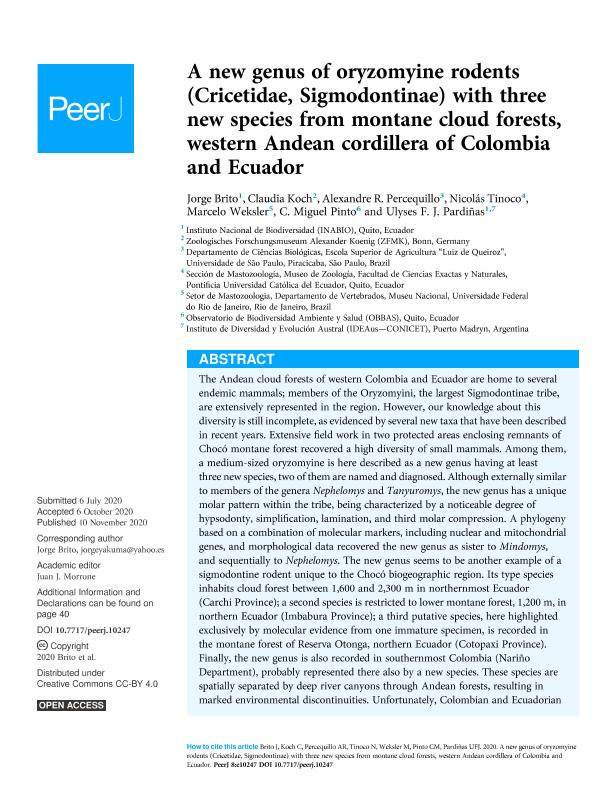Mostrar el registro sencillo del ítem
dc.contributor.author
Brito, Jorge
dc.contributor.author
Koch, Claudia
dc.contributor.author
Reis Percequillo, Alexandre

dc.contributor.author
Tinoco, Nicolás
dc.contributor.author
Weksler, Marcelo

dc.contributor.author
Pinto, C. Miguel
dc.contributor.author
Pardiñas, Ulises Francisco J.

dc.date.available
2021-09-02T01:27:11Z
dc.date.issued
2020-11-10
dc.identifier.citation
Brito, Jorge; Koch, Claudia; Reis Percequillo, Alexandre; Tinoco, Nicolás; Weksler, Marcelo; et al.; A new genus of oryzomyine rodents (Cricetidae, Sigmodontinae) with three new species from montane cloud forests, western Andean cordillera of Colombia and Ecuador; PeerJ Inc.; PeerJ; 8; 10-11-2020; 1-49
dc.identifier.issn
2167-8359
dc.identifier.uri
http://hdl.handle.net/11336/139499
dc.description.abstract
The Andean cloud forests of western Colombia and Ecuador are home to several endemic mammals; members of the Oryzomyini, the largest Sigmodontinae tribe, are extensively represented in the region. However, our knowledge about this diversity is still incomplete, as evidenced by several new taxa that have been described in recent years. Extensive field work in two protected areas enclosing remnants of Chocó montane forest recovered a high diversity of small mammals. Among them, a medium-sized oryzomyine is here described as a new genus having at least three new species, two of them are named and diagnosed. Although externally similar to members of the genera Nephelomys and Tanyuromys, the new genus has a unique molar pattern within the tribe, being characterized by a noticeable degree of hypsodonty, simplification, lamination, and third molar compression. A phylogeny based on a combination of molecular markers, including nuclear and mitochondrial genes, and morphological data recovered the new genus as sister to Mindomys, and sequentially to Nephelomys. The new genus seems to be another example of a sigmodontine rodent unique to the Chocó biogeographic region. Its type species inhabits cloud forest between 1,600 and 2,300 m in northernmost Ecuador (Carchi Province); a second species is restricted to lower montane forest, 1,200 m, in northern Ecuador (Imbabura Province); a third putative species, here highlighted exclusively by molecular evidence from one immature specimen, is recorded in the montane forest of Reserva Otonga, northern Ecuador (Cotopaxi Province). Finally, the new genus is also recorded in southernmost Colombia (Nariño Department), probably represented there also by a new species. These species are spatially separated by deep river canyons through Andean forests, resulting in marked environmental discontinuities. Unfortunately, Colombian and Ecuadorian Pacific cloud forests are under rapid anthropic transformation. Although the populations of the type species are moderately abundant and occur in protected areas, the other two persist in threatened forest fragments.
dc.format
application/pdf
dc.language.iso
eng
dc.publisher
PeerJ Inc.
dc.rights
info:eu-repo/semantics/openAccess
dc.rights.uri
https://creativecommons.org/licenses/by/2.5/ar/
dc.subject
ANDES
dc.subject
CHOCÓ
dc.subject
HYPSODONTY
dc.subject
MINDOMYS
dc.subject
NEPHELOMYS
dc.subject
ORYZOMYINI
dc.subject.classification
Zoología, Ornitología, Entomología, Etología

dc.subject.classification
Ciencias Biológicas

dc.subject.classification
CIENCIAS NATURALES Y EXACTAS

dc.title
A new genus of oryzomyine rodents (Cricetidae, Sigmodontinae) with three new species from montane cloud forests, western Andean cordillera of Colombia and Ecuador
dc.type
info:eu-repo/semantics/article
dc.type
info:ar-repo/semantics/artículo
dc.type
info:eu-repo/semantics/publishedVersion
dc.date.updated
2021-04-28T21:02:12Z
dc.journal.volume
8
dc.journal.pagination
1-49
dc.journal.pais
Estados Unidos

dc.description.fil
Fil: Brito, Jorge. Instituto Nacional de Biodiversidad; Ecuador
dc.description.fil
Fil: Koch, Claudia. Zoologisches Forschungsmuseum Alexander Koenig.; Alemania
dc.description.fil
Fil: Reis Percequillo, Alexandre. Universidade do Sao Paulo. Escola Superior de Agricultura Luiz de Queiroz; Brasil
dc.description.fil
Fil: Tinoco, Nicolás. Pontificia Universidad Católica del Ecuador; Ecuador
dc.description.fil
Fil: Weksler, Marcelo. Universidade Federal do Rio de Janeiro; Brasil
dc.description.fil
Fil: Pinto, C. Miguel. Observatorio de Biodiversidad Ambiente y Salud; Ecuador
dc.description.fil
Fil: Pardiñas, Ulises Francisco J.. Instituto Nacional de Biodiversidad; Ecuador. Consejo Nacional de Investigaciones Científicas y Técnicas. Centro Científico Tecnológico Conicet - Centro Nacional Patagónico. Instituto de Diversidad y Evolución Austral; Argentina
dc.journal.title
PeerJ
dc.relation.alternativeid
info:eu-repo/semantics/altIdentifier/doi/http://dx.doi.org/10.7717/peerj.10247
dc.relation.alternativeid
info:eu-repo/semantics/altIdentifier/url/https://peerj.com/articles/10247/
Archivos asociados
